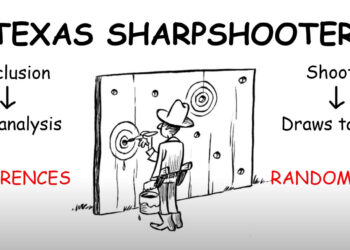It’s often difficult to tell a complex story around data. It takes patience, engagement, and excellent execution. This infographic presentation tackles the topic of income inequality in a manner that I found riveting and extremely effective.
And that’s the way it is.
Discussion
12 Thoughts on "The 1% Infographic Animation — An Exercise in the Slow Shock of Reality"
I posted this same video on my personal facebook page, and got slammed for posting a video that “promoted discontent, and a Robin Hood-esque redistribution of wealth.” I couldn’t understand how such an elegant and engaging presentation could be so badly misunderstood.
Truly amazing video. I must admit – I was pretty far off in what I thought was the distribution myself – 40% of wealth with the top 1% blew me away!
Good presentation, good at making the point about the steep inequality in wealth distribution – and that was a few years ago. Imagine how much worse it is now!
3.8M views, or 1.2% of the US population… More views are needed.
interesting, but the presentation conflates wealth and income–clearly related, but not the same thing.
Yes, you can potentially build wealth even if you have a relatively small income. Building wealth requires the ability to save – advisors usually quote 10% of income as a good starting point, but you can’t do this if it takes 110% (or more) of your income just to pay for basic rent and food so that you can go out and get work. That’s where we are right now for the lowest earners in the country.
I watched a “live” presentation of simlar data some 15 years ago at Stanford Publishing Course. A very entertaining scholar unfurled a folded card pack to demonstrate the wealth disparity. The length of the 1% pack wouldn’t fit on stage. “Everything must change so that everything can stay the same,” Il Gattopardo, –Lampedusa
A really great visualization for explaining complicated (?) numbers. Thanks for sharing.
Income is much more evenly distributed than wealth as wealth excludes the value of human capital. Most people are confused about this, hence the difference between perception and reality as shown in the video.
Yes, this is a key point. It is certainly a striking video, and I find some of the facts in it upsetting (I certainly don’t like the wealth distribution we actually have), but one thing it demonstrates is that the Americans being surveyed have no idea what the wealth distribution should look like in any society they would consider living in.
I looked up the original survey results (Michael I. Norton and Dan Ariely, Building a Better America–One Wealth Quintile at a Time, Perspectives on Psychological Science 2011 6: 9-12, http://dx.doi.org/10.1177/1745691610393524). Given a choice between America’s actual wealth distribution and the _income_ distribution of Sweden presented as a wealth distribution, they found that 92% of Americans chose the latter distribution as preferable. However, substituting income for wealth is very misleading, as the authors admit in a footnote:
“We used Sweden’s income rather than wealth distribution because it provided a clearer contrast to the other two wealth distribution examples; although more equal than the United States’ wealth distribution, Sweden’s wealth distribution is still extremely top heavy.”
In fact, a skewed distribution of wealth is basically unavoidable, and the Swedish-income-based wealth distribution is not even within the range of theoretical possibilities for any society remotely like the U.S. (or, for that matter, Sweeden).
For example, imagine the following toy model. In our ideal society, every worker makes exactly the same salary, regardless of job or seniority. Everyone starts with no savings or inheritance, works for fifty years, and then spends ten years in retirement. At the end of each working year, every worker deposits a fixed amount into a savings account and also receives 3% interest on their previous savings. Once they retire, they spend down the savings account at 10% per year and then die after the tenth year. Let’s also assume a static population size.
Of course this model is ridiculously simplified, but the less realistic parts underestimate real-world inequality. (If some people make more money or choose to save more, then wealth inequality will increase. Population growth means extra young people who have not had time to accumulate as much savings. Etc.) So I see this as giving a baseline: it’s unreasonable to expect more wealth equality than this egalitarian model predicts.
If you do the calculation, you find that in this model, the bottom quintile has 2% of the wealth, while the top quintile has 42%. Specifically, the distribution is 2%, 9%, 18%, 29%, 42%. It’s an awful lot more uniform than our actual distribution, as it should be given how the model was set up, but it is still pretty skewed. These results should not be surprising: the bottom quintile consists of workers in their first ten years, who have not yet had much time to save, and retirees in their last two years, who have spent most of their savings. Of course they have a lot less wealth.
By contrast, the Swedish income distribution used in the article was 11%, 15%, 18%, 21%, 36%. Unless you severely discourage long-term saving, it’s difficult to see how you could possibly have a wealth distribution that looks like this. Sweden certainly doesn’t, and it would be impossible in the U.S. without radical changes to laws and customs.
For comparison, suppose we replaced the 3% interest in the model with a 10% yearly pre-retirement wealth tax (i.e., every year you lose 10% of your savings). That evens out the wealth distribution a lot, but not completely: 6%, 18%, 24%, 26%, 26%. Even in this extreme model, the top quintile still has more than four times as much wealth as the bottom quintile.
What this tells us is that you can’t get meaningful results by surveying 5000 people who have never thought about a subject. I also think the authors biased the results by including the instructions “In considering this question, imagine that if you joined this nation, you would be randomly assigned to a place in the distribution, so you could end up anywhere in this distribution, from the very richest to the very poorest.” This encourages respondents to think of the quintiles as describing fixed characteristics of members of society, rather than similar people at different life stages. Of course the truth is a mixture of both perspectives (and fixed characteristics play far too large a role in practice), but I wonder what the results would have been if the instructions had instead read “In considering this question, keep in mind that people often move between quintiles over time. For example, fresh college graduates may have almost no savings, but they may accumulate substantial wealth by the time they retire.”



